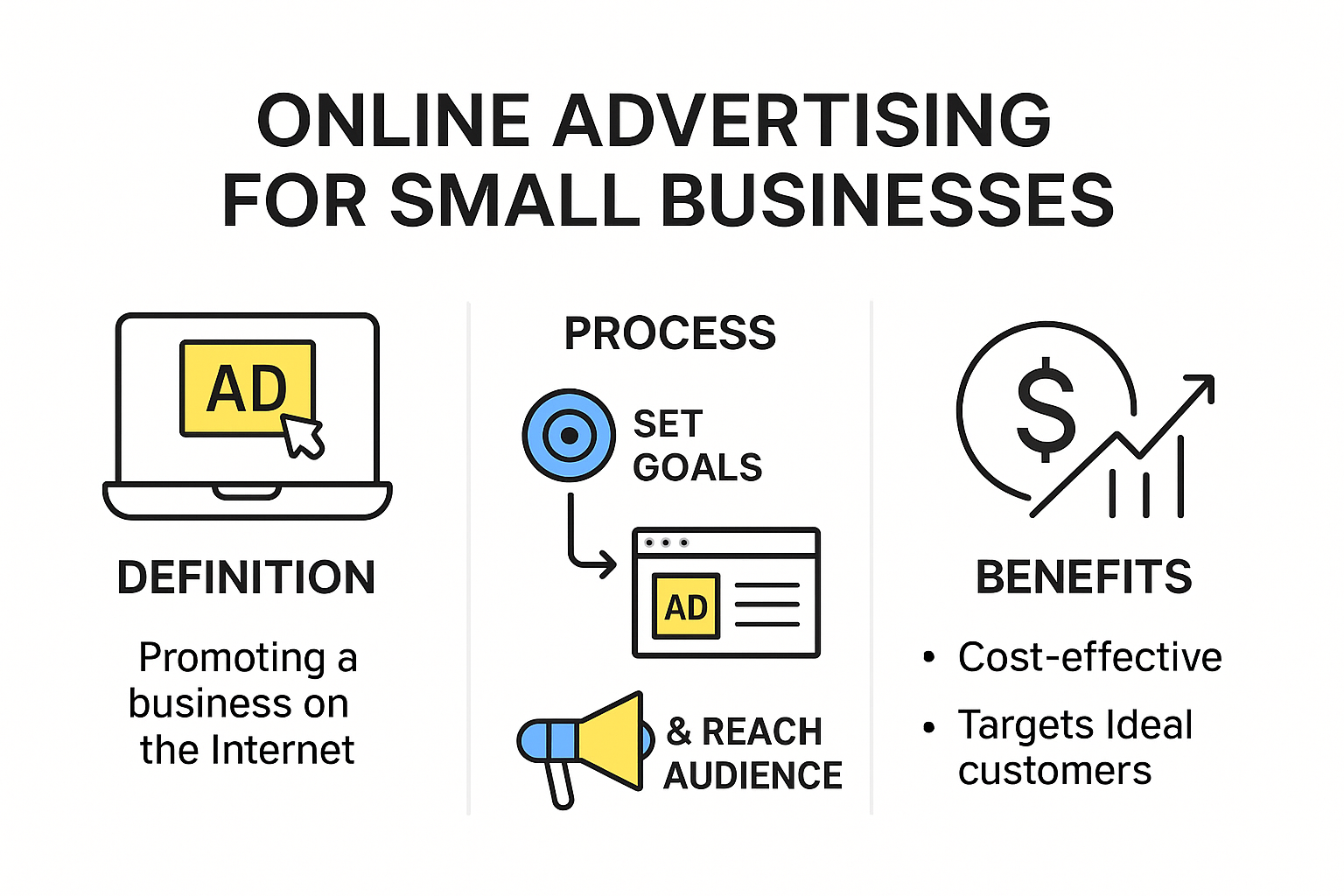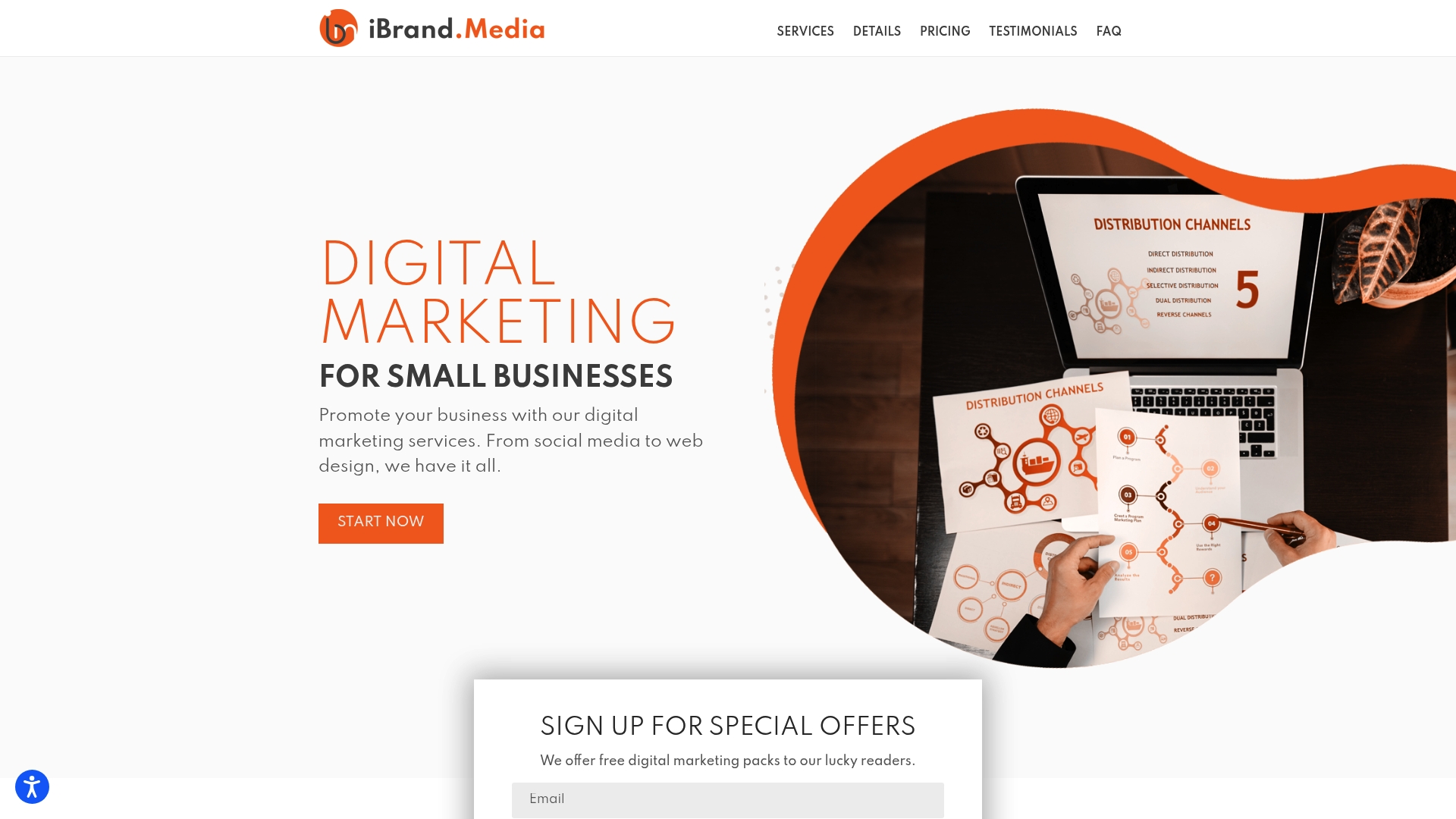Online advertising gives small businesses a shot at reaching customers far beyond their neighborhoods. But did you know that email marketing returns up to $42 for every $1 spent. That is higher than almost any digital channel out there. Most owners assume online ads are just for big brands, but targeted digital campaigns can actually give the little guy a serious edge. Get ready to discover how smart strategies help small businesses win online.
Table of Contents
- What Is Online Advertising For Small Businesses
- Key Types Of Online Advertising Explained
- Building An Effective Online Ad Strategy On A Budget
- Common Challenges And How To Overcome Them
Quick Summary
| Takeaway | Explanation |
|---|---|
| Online advertising expands customer reach | It allows small businesses to connect with potential customers through various digital channels using targeted marketing strategies. |
| Set clear marketing objectives | Define specific, measurable goals before advertising to guide your strategy and budget allocation effectively. |
| Experiment with different ad types | Use a mix of search, social media, email, and display advertising to find the most effective channels for your audience. |
| Utilize budget-friendly techniques | Leverage cost-effective advertising strategies such as geo-targeting and repurposing existing content to maximize impact. |
| Continuously measure ad performance | Regularly analyze metrics like click-through and conversion rates to optimize your advertising strategies for better results. |
What Is Online Advertising for Small Businesses
Online advertising represents a powerful digital strategy that enables small businesses to reach potential customers through internet-based marketing channels. At its core, online advertising involves placing promotional content across digital platforms to attract, engage, and convert target audiences.

The Fundamental Components of Digital Marketing
Small businesses can leverage multiple online advertising approaches to expand their reach. The U.S. Small Business Administration recommends developing a comprehensive marketing plan that integrates various digital channels. These channels typically include:
- Search Engine Advertising: Placing targeted ads that appear when potential customers search for relevant keywords
- Social Media Marketing: Creating promotional content on platforms where your target audience spends time
- Display Advertising: Using visual advertisements across websites and applications
- Email Marketing: Sending targeted promotional messages directly to potential customer inboxes
Strategic Approach to Online Advertising
Successful online advertising for small businesses requires a strategic and measured approach. The U.S. Chamber of Commerce highlights four primary advertising strategies that can help small businesses maximize their digital marketing efforts:
- Paid search advertising allows businesses to appear at the top of search results for specific keywords
- Social media advertising enables precise demographic and interest-based targeting
- Native advertising integrates promotional content seamlessly within relevant online platforms
- Display advertising uses visual banners and graphics to capture audience attention
The Better Business Bureau emphasizes that digital advertising provides a cost-effective method for small businesses to reach broader audiences. By investing strategically in online advertising, businesses can generate brand awareness, drive website traffic, and ultimately increase sales conversions.
Understanding online advertising is not just about spending money on ads but creating meaningful connections with potential customers through targeted, relevant, and engaging digital content. Small businesses that approach online advertising with clear goals, understanding of their target audience, and willingness to adapt their strategies will see the most significant returns on their marketing investments.
Key Types of Online Advertising Explained
Online advertising offers small businesses a diverse range of strategies to connect with potential customers. Understanding the different types of online advertising helps entrepreneurs make informed decisions about their digital marketing investments.
Search Engine Advertising: Capturing Immediate Interest
Search engine advertising represents one of the most direct forms of online marketing. Google Ads Research Center reveals that search ads can generate significant visibility for businesses targeting specific keywords. These advertisements appear directly in search results when potential customers look for related products or services.
Small businesses can leverage two primary search advertising approaches:
- Pay-Per-Click (PPC) Advertising: Businesses pay only when someone clicks their advertisement
- Sponsored Search Results: Paid placements that appear at the top or side of search engine results pages
To help clarify the key features and advantages of each main type of online advertising mentioned, the following table summarizes their approaches, benefits, and typical use-cases for small businesses:
| Type of Online Advertising | Main Approach | Key Benefits | Typical Use-Cases |
|---|---|---|---|
| Search Engine (PPC/Sponsored) | Appear in search engine results for specific keywords | High visibility, immediate traffic | Capturing intent-driven leads |
| Social Media | Targeted ads based on demographics/interests | Precise targeting, visual engagement | Promoting content, brand awareness |
| Display Advertising | Visual banners/graphics on websites and apps | Broad reach, strong branding | Reminders, retargeting, promotions |
| Email Marketing | Direct promotional messages to customer inboxes | High ROI, personalized communication | Nurturing leads, repeat sales |
| Native Advertising | Integrated, non-disruptive promotional content | Blends with content, high contextual relevance | Subtle promotion within relevant sites |
Social Media and Display Advertising: Visual Engagement Strategies

Pew Research Center indicates that over 72% of adults use social media platforms, making them crucial advertising channels. Social media advertising allows businesses to target specific demographics with precision. Display advertising complements these efforts by using visual banners and graphics across websites and applications.
Key features of social media and display advertising include:
-
Demographic Targeting: Reach specific age groups, interests, and geographic locations
-
Visual Storytelling: Create compelling graphics and videos that capture audience attention
-
Retargeting Capabilities: Show advertisements to users who have previously visited your website
Email and Native Advertising: Subtle and Direct Approaches
Email marketing remains a powerful tool for small businesses. Campaign Monitor reports that email campaigns can generate up to $42 for every $1 spent. Native advertising offers another sophisticated approach, integrating promotional content seamlessly within relevant online platforms.
These advertising methods provide unique advantages:
-
Personalized Communication: Craft targeted messages that speak directly to customer interests
-
Cost-Effective Reach: Achieve significant audience engagement with minimal investment
-
Contextual Relevance: Create advertisements that blend naturally with surrounding content
Effective online advertising requires a strategic approach that combines multiple channels. Small businesses should experiment with different advertising types, track performance metrics, and continuously refine their digital marketing strategies to maximize return on investment.
Building an Effective Online Ad Strategy on a Budget
Creating an impactful online advertising strategy doesn’t require massive financial resources. Small businesses can achieve significant marketing results by implementing smart, targeted approaches that maximize every advertising dollar spent.
Setting Clear Marketing Objectives
The Federal Trade Commission emphasizes the importance of establishing clear advertising goals before investing resources. Small businesses should define specific, measurable objectives such as increasing website traffic, generating leads, or boosting sales conversions. These objectives serve as a strategic compass for allocating advertising budgets and selecting appropriate digital marketing channels.
Key considerations for setting marketing objectives include:
- Specific Target Metrics: Define precise numerical goals like 20% website traffic increase
- Time-Bound Expectations: Create realistic timelines for achieving marketing objectives
- Alignment with Business Goals: Ensure advertising strategy supports overall business growth
Budget-Friendly Advertising Techniques
Smart small businesses can leverage cost-effective digital advertising strategies that deliver maximum impact with minimal investment. Techniques like organic social media content, targeted local advertising, and strategic keyword selection can help businesses reach potential customers without breaking the bank.
The following checklist table summarizes several budget-friendly online advertising strategies discussed, along with their main advantages:
| Strategy | Description | Cost-Effective? | Main Advantage |
|---|---|---|---|
| Geo-Targeted Advertising | Focus ads on local geographic regions | Yes | Reaches local, interested audience |
| Long-Tail Keyword Strategies | Target specific, less competitive search terms | Yes | Lower ad cost, higher conversion |
| Repurposing Content | Adapt existing materials for multiple campaigns | Yes | Maximizes value of content |
| Organic Social Media | Share content without paid promotion | Yes | Builds audience for free |
| Free Analytics Tools | Use tools like Google Analytics | Yes | Monitors and improves performance |
Measuring and Optimizing Ad Performance
Constant performance tracking distinguishes successful online advertising strategies from ineffective ones. Small businesses must regularly analyze advertising metrics to understand which strategies generate the best returns. Google Analytics provides free tools that help businesses track website traffic, user engagement, and conversion rates.
Critical performance metrics to monitor include:
- Click-Through Rates: Measure the percentage of users who click on advertisements
- Conversion Rates: Track how many ad interactions result in desired actions
- Cost Per Acquisition: Calculate the expense of acquiring each new customer
Successful online advertising on a budget requires creativity, strategic planning, and continuous learning. Small businesses that remain flexible, experiment with different approaches, and closely monitor their advertising performance can achieve remarkable marketing results without substantial financial investment. The key lies in understanding your target audience, crafting compelling messages, and systematically refining your digital marketing approach.
Common Challenges and How to Overcome Them
Online advertising presents numerous challenges for small businesses navigating the complex digital marketing landscape. Understanding these obstacles and developing strategic solutions can help entrepreneurs maximize their marketing efforts and minimize potential setbacks.
Budgetary and Resource Limitations
Research from Acta Universitatis Danubius reveals that small and medium-sized enterprises often struggle with significant barriers in internet marketing. These challenges include high start-up costs, unclear return on investment, and limited access to advanced digital technologies.
Small businesses can address these limitations through:
- Cost-Effective Tools: Utilize free or low-cost marketing platforms
- Strategic Budget Allocation: Focus spending on high-performing channels
- Skill Development: Invest in learning digital marketing fundamentals
Targeting and Audience Engagement
Facebook advertising research indicates that while 71% of advertisers are small and medium-sized businesses, only 32% effectively utilize micro-targeting capabilities. This suggests a significant gap in understanding sophisticated audience engagement strategies.
Key strategies to improve targeting include:
- Detailed Audience Segmentation: Create precise customer personas
- Data-Driven Targeting: Use analytics to refine audience selection
- Continuous Learning: Experiment with different targeting approaches
Technical Complexity and Performance Optimization
Forbes research emphasizes the importance of organic marketing strategies that provide long-term benefits without extensive financial investment. Small businesses must develop a nuanced approach to overcome technical challenges in online advertising.
Effective techniques for managing technical complexity include:
- Regular Performance Analysis: Track key marketing metrics consistently
- Continuous Education: Stay updated on digital marketing trends
- Flexible Strategy Adaptation: Quickly adjust campaigns based on performance data
Successful online advertising requires persistent learning, strategic thinking, and adaptability. Small businesses that approach digital marketing with patience, curiosity, and a willingness to experiment will ultimately overcome common challenges and develop robust advertising strategies that drive meaningful business growth.
Frequently Asked Questions
What is online advertising for small businesses?
Online advertising for small businesses involves using various digital marketing channels to promote products and services to potential customers online. This can include search engine advertising, social media marketing, display ads, and email marketing.
How can small businesses benefit from online advertising?
Small businesses can benefit from online advertising by reaching a wider audience, generating brand awareness, driving website traffic, and increasing sales conversions. Targeted digital campaigns allow them to compete effectively with larger brands.
What types of online advertising are best for small businesses?
Some effective types of online advertising for small businesses include search engine ads (like Google Ads), social media advertising, email marketing, display ads, and native advertising. Utilizing a mix of these channels can optimize marketing results.
How can small businesses create an online advertising strategy on a budget?
Small businesses can create a budget-friendly online advertising strategy by setting clear marketing objectives, utilizing cost-effective techniques (such as geo-targeting and repurposing content), and continuously measuring ad performance using tools like Google Analytics.
Ready to Turn Online Advertising Challenges Into Real Business Growth?
Are you feeling overwhelmed by the complexity and rising costs of digital marketing? This guide highlighted how small businesses face budget limits, struggle to stand out among competitors, and must juggle multiple ad strategies just to stay visible. Many owners worry about wasting precious dollars or missing out on new customers because their ads are not targeted or measured effectively.

Imagine having a dedicated team handle your local marketing, advertising, and performance tracking with transparent pricing you can trust. At ibrand.media, we specialize in affordable, customized solutions that let small businesses capture leads and boost sales online—fast. If you want results without unpredictable costs or stressful trial and error, let us build your tailored strategy today. Visit https://ibrand.media now and request your custom plan so you can finally focus on growing your business while we drive your online success.

Recent Comments